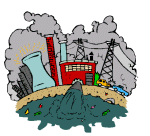
Industry & Power Generation
 The two major air pollutants produced by industry and power stations are sulphur dioxide and nitrogen oxides. Sulphur dioxide is the main pollutant given off by power stations. In Britain, 90% of sulphur dioxide pollution comes from power stations and industry. Sulphur dioxide was once a major air pollutant in cities. It would mix with smoke given off when coal was burnt to produce smog.
The two major air pollutants produced by industry and power stations are sulphur dioxide and nitrogen oxides. Sulphur dioxide is the main pollutant given off by power stations. In Britain, 90% of sulphur dioxide pollution comes from power stations and industry. Sulphur dioxide was once a major air pollutant in cities. It would mix with smoke given off when coal was burnt to produce smog.
Today, industries that emit sulphur dioxide must have chimneys or stacks which release the waste gases into the atmosphere at higher levels, thereby reducing the amount of ground level pollution. Power stations are now also required to reduce the amount of sulphur dioxide they give off by using specialised clean technology.
Nitrogen oxides are pollutants which are mainly associated with car exhausts, although some comes from industry. Both nitrogen oxides and sulphur dioxide can be harmful to human health. In addition, they also lead to acid rain.
The biochemical mechanisms by which ozone interacts with plants have been intensively studied. There is a consensus that the key event in plant responses is oxidative damage to cell membranes. This primary oxidative damage to cell membranes results in the inhibition of essential biochemical and physiological processes, including photosynthesis. These changes result in reduced growth in many plants, although this varies from plant to plant and species to species. Ozone may also increase the severity of many fungal diseases.